#philippe-hauer
Explore tagged Tumblr posts
Text


Charles Bronson in The White Buffalo (J. Lee Thompson, 1977) Rutger Hauer in A Breed Apart (Philippe Mora, 1984)
#Charles Bronson#Rutger Hauer#comparison#The White Buffalo#J. Lee Thompson#A Breed Apart#Philippe Mora#genre cinema#film#movies
1 note
·
View note
Text
Hot Medieval & Fantasy Men Melee Masterpost
Qualifying Round: Day 5
Philippe Gaston [Matthew Broderick] VS. Will Scarlet O'Hara [Matthew Poretta]
Ahmad [Mahesh Jadu] VS. Glenstorm [Cornell John]
Henry II [Peter O'Toole] VS. Henry II [Peter O'Toole] (This is not a mistake. There are two DIFFERENT versions of Henry II both played by Peter O'Toole in separate, unrelated properties)
Trumpkin [Peter Dinklage] VS. Ahmed Ibn Fahdlan [Antonio Banderas]
Thraxus Boorman [Amar Chadha-Patel] VS. Tyrion Lannister [Peter Dinklage]
Daemon Targaryen [Matt Smith] VS. Durotan [Toby Kebbell]
Rosencrantz [Gary Oldman] VS. Lord Harekr [Bradley James]
Etienne de Navarre [Rutger Hauer] VS. Prince John [Richard Lewis]
Renly Baratheon [Gethin Anthony] VS. Fíli [Dean O'Gorman]
Merry Brandybuck [Dominic Monaghan] VS. Fjölnir [Claes Bang]
Ravenhurst [Basil Rathbone] VS. The Player [Richard Dreyfuss]
Francois Villon [Ronald Colman] VS. Prince Prospero [Vincent Price]
Richard II [Ben Whishaw] VS. Will Scarlett [Christian Slater]
Fezzik [Andre the Giant] VS. Saladin [Milind Soman]
Will Scarlett [Harry Lloyd] VS. George Plantagenet [David Oakes]
Faramir [David Wenham] VS. Richard Cypher [Craig Horner]
Francesco de Pazzi [Matteo Martari] VS. Geoffrey Chaucer [Pier Paolo Pasolini]
Jareth [David Bowie] VS. Jafar [Marwan Kenzari]
Prince Dastan [Jake Gylenhaal] VS. Sir Guy of Gisborne [Richard Armitage]
Geralt of Rivia [Henry Cavill] VS. Roose Bolton [Michael McElhatton]
13 notes
·
View notes
Text
So, in response to tags on this post re: a Daniel Henney/Navarre Ladyhawke scenario, I have been thinking for DAYS on who else one would cast.
To make it fun you really want to set boundaries. Stick to a) people you can cast now (it's not open choice eg you can't cast Gene Tierney then with DH now, it has to be both here and now), and b) be of an equivalent career profile (aka you can't cast some rando from an advertisment), and c) stick within the general vibe and age range of the original narrative. However point c) has really challenged me, as I looked up the ages of the original cast for comparison and it has not satisfied me re: contemp. casting.
For example, Rutget Hauer was 41, and Michelle Pfeiffer was 27. Daniel Henney is 44, so far so good, but then when I went looking at actors in the 27 year age bracket I get like the Ella Purnells and Daisy Edgar Joneses and Anya Taylor Joys of the world? I get that people who notably played teens on screen recently are not actual teenagers, i do know this... but the idea of casting, like, one of the flashback Yellowjackets vs Daniel Henney (44) bores me to tears. BORES ME to TEARS. Navarre/Isabeau, despite sharing very little screentime, have a feeling of being adults of an equivalent experience/confidence/capability, perhaps because they are both the Adults when compared to Philippe's Youth, and the Bishop's and Imperius' Age. Phillipe has to seem like a teenager to her, but he'll be a mid-20's actor already so like I'm not super keen on casting gorgeous models who have yet to see the fun side of 30.
But also like Zöe Robins is in her early 30s and the vibe they have in WoT seems dynamic and interesting between them, so I'd not averse to ZR as Isabeau for for funsies, and just have a WoT LadyhawkeAU. However, I scouted around by going up a decade for the hell of it.
Front runners are: Jodie Turner Smith (you definely go 'holy shit that is the Face of Love', and she can play a quiet dignity combined with a 'i do what i want' vibe); hard to miss Keira 'queen of costume' Knightley (you KNOW she could do it, and she does 'pining and pissed off' so well); but my fave is Sofia Boutella - Isabeau does a lot of no-dialogue scenes of her Looking and Reacting to things, rolling her eyes at Phillipe, thinking about things silently, and Pining, and Boutella is a spectacular no-dialogue actor. She has a dance background, so no surprise I guess. I mean she's been in a lot of action-heavy stuff with minimal/expository dialogue, and you can SEE her feelings. She can do angry and vulnerable and quiet in combination. She can rock a 'i cut my own hair off' look like no problem.
Imperius is Simon Russell Beale. I just like to see him in everything.
Casting Phillipe the Mouse is impossible. IMPOSSIBLE. Ladyhawke is essentially a 2-hander, times 2, because Isabeau and Navarre can't interact due to the uhhhhh central premise of the movie. That means the actual on-screen chemistry has to be between Isabeau|Phillipe, and Navarre|Phillipe (| or / depending on your chemstry preferences I guess).
Due to the age range, you're looking at bascially the kind of people who get cast as one of the kids in Stranger Things, and I recoil. Broderick's entire brand is built on having so much Ferris Bueller youthful rocket-fuel charisma he literally defined the man-child archetype at 23. I cannot think of anyone working now in that age bracket who I would not immediately tell to STFU anytime they were on screen. Idk, find some kid who is live on stage as Billy Elliot or in Matilda right now somewhere, that's probably your best bet
#karis-the-fangirl#zombeesknees#queenofattolia#i'm not like committed to any of these - hit me with alternatives!#text post shenanigans
11 notes
·
View notes
Note
how would you cast a remake of ladyhawke?
LIV I'M SO GLAD YOU ASKED.
Etienne of Navarre--easiest, this would be Adam Driver, with someone (or like six someones) dragging him by his lush long hair to play a romantic lead, and justifying it by telling him he's a wolf for like half the movie. Adam has the physicality, and can you IMAAAAAGINE the pure unadultered angst that would be him bellowing into the snow after Etienne and Isabeau get THISCLOSE to touching in their human forms as the sun breaks the horizon??? MY. GOD.
Isabeau of Anjou--this has to be a woman who's so beautiful that you have to believe that her rejection would drive a psychotic priest to great villainy, drive a man to save her even after he's been turned into a wolf by night, and also walk in the footsteps of Michelle Pfeiffer. a HEAVY task all around. I also think the physicality of these roles is important. So you've gotta have someone who's god Cheekbones.
And this is where I get a bit controversial and say I would indeed cast Zendaya as Isabeau against Adam Driver's Etienne. "Oh, there's a 13 year age difference" well how about this??? A) that is almost the same age difference Rutger Hauer and Michelle Pfeiffer had in the original and B) I don't give a fuck.
It has long been a secret, except not secret to you, desire of mine to see these two play off each other, and THIS! THIS IS WHERE I WANT IT! Imagine him spinning her around at the end? Spinning her around like she is but a feather in his meaty paws? How happy I would be. I'd almost forget that I live in a dystopian nightmare.
There'd be a scene where he bench presses her in a flashback just for meeeee--
Philippe Gaston "The Mouse"--Tom Holland nah we're gonna do something good here. The Mouse is a guy I find a bit annoying in the movie because he's like, intruding on my tragic cursed love story, but he's also funny because he basically has the same reactions I do. He watches Etienne scream into the void and he like, sobs, and same. So I'd cast Justice Smith as The Mouse, because he's funny and charismatic and also would, I think, actually be hilarious next to brooding Adam Driver Etienne. OR. OR we'd do something totally different, rewrite the role entirely, and it would be Jack Black. Those are the options I offer.
The Bishop--Ian McShane. That's all. You're good. And you know, Ian McShane is so charismatic that we'd be all "maybe in another life--" until he did something super bad.
There you goooo
16 notes
·
View notes
Text

Le 27 avril 2024 au CipM, la revue Watts était à l'honneur, pour une rencontre autour des pratiques de la traduction ! Merci à Hauer Philippe d'avoir défendu l'idée d'une telle rencontre, merci à toute l'équipe du CipM. La photo (copiée sur l'instagram du CipM) montre Philippe Hauer, Samuel Rochery, et Simon Brown (en direct du Québec). Excellent souvenir ! On a lu Lisa Jarnot, Sanya Noël, Amy Lawless, Carrie Bennet et Sylvester Stallone (et on s'est pos�� des questions au sujet de Sylvester)
0 notes
Link
le dernier livre de Jérôme Bertin vient de sortir ! un Cas Soc’ de toute beauté, à cette occasion un article dans lib’critique sur l’écriture de Jérôme Bertin, en général, dans Cas Soc’ en particulier, petite étude de la page 9, par mes soins et de façon non-exhaustive…
3 notes
·
View notes
Text

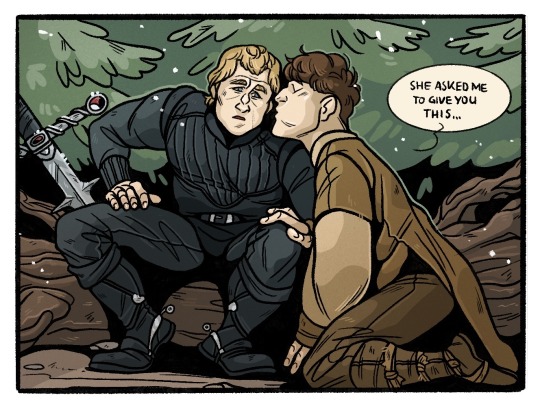


I watched Ladyhawke (1985) and I just couldn't help but think about that this might have happened! 😭💜✨ And I also ... wrote a 9k one shot fanfic about it over on AO3!
#ladyhawke (1985)#ladyhawke#rutger hauer#etienne navarre#philippe gaston#isabeau d'anjou#matthew broderick#michelle pfeiffer#fan art#profgoesdigital#fanart
518 notes
·
View notes
Photo



Rutger Hauer in A Breed Apart [1984]
#A Breed Apart#Jim Malden#rutger hauer#Philippe Mora#рутгер хауэр#MY EDIT#MY GIF POSTS#RUTGER HAUER EDIT
51 notes
·
View notes
Photo

All those VHS covers will be lost in time, like tears in rain...
57 notes
·
View notes
Photo

2049 / Precious Find (1996) Scanbox https://www.videospace.fi/release/2049_vhs_scanbox_finland
#Videospace#VHS#2049#Precious Find#Philippe Mora#Rutger Hauer#Joan Chen#Harold Pruett#VHS tapes#VHS art#VHS cover
0 notes
Photo





Rutger Hauer in A Breed Apart (1984) dir. Philippe Mora
90 notes
·
View notes
Text
5 underrated Richard Donner movies you need to see
https://ift.tt/eA8V8J
Richard Donner will forever be remembered as the filmmaker who created the blueprint for the modern superhero blockbuster with 1978’s Superman starring Christopher Reeve.
Yet that doesn’t tell even half the story of the Bronx-born filmmaker’s brilliant filmography.
Donner was in his late 40s by the time Superman came along, having made a name for himself in Hollywood two years earlier, with 1976’s suitably terrifying The Omen.
Prior to that, he was a budding director making the transition from the small screen to the world of cinema. Donner worked on everything from Gilligan’s Island to The Twilight Zone. Even then, it was clear he was destined for bigger things though, as anyone who saw “Nightmare at 20,000 Feet”, the iconic episode of The Twilight Zone he directed, starring William Shatner, can attest.
While a disagreement with producers ultimately saw him walk away from Superman II, the 1980s saw Donner establish himself as an incredibly versatile big budget director capable of handling everything from the epic family adventure fun of The Goonies to the balancing act of action and comedy found within the buddy cop antics of Lethal Weapon.
It was a skillset that drew admiration from the very best in the movie industry, including Steven Spielberg who was among the first to pay tribute to Donner after learning he had passed away, aged 91.
“Dick had such a powerful command of his movies, and was so gifted across so many genres,” Spielberg, who worked with Donner on The Goonies, said.
“Being in his circle was akin to hanging out with your favourite coach, smartest professor, fiercest motivator, most endearing friend, staunchest ally, and – of course – the greatest Goonie of all.”
Donner may not have had the same impact in the 1990s and early 2000s but he still enjoyed major success with the Lethal Weapon franchise and as a producer with movies like Free Willy and X-Men.
More importantly, the other films he made during that period and in the years between some of his biggest hits remain well worth revisiting or seeking out for the first time – starting with these five.
Ladyhawke
Coming hot on the heels of The Goonies and two years prior to Lethal Weapon, Ladyhawke represented another major departure for Donner. A dark medieval fantasy, it centred on Rutger Hauer’s mysterious Captain Etienne Navarre and his female companion Lady Isabeau (Michelle Pfeiffer), a pair of star-crossed lovers on the run from a vengeful bishop who has placed a demonic curse on their heads. While Navarre transforms into a wolf by night, Isabeau exists as a Hawk by day. Teaming up with petty thief Philippe Gaston (Matthew Broderick) they embark on a quest to overthrow the evil bishop and break the spell.
Something of a passion project, Donner had attempted to get Ladyhawke off the ground several times before finally getting the green light from Warner Bros and 20th Century Fox in the mid ’80s. The film then suffered another setback when Kurt Russell, originally cast as Navarre, dropped out during rehearsals.
That ultimately proved a blessing in disguise with Hauer going on to deliver arguably his best performance since Blade Runner. Not everything about Ladyhawke works – Broderick’s character feels a little too close to Ferris Bueller while the runtime could be trimmed down – but it remains a beautifully realised fantasy epic, full of memorable action set pieces, stunning cinematography and a spellbinding turn from Pfeiffer.
A box office bomb upon release, Ladyhawke has stood the test of time too, garnering a cult following as an authentic and fresh take on the sword and sorcery formula.
Maverick
Maverick is the film Will Smith must have hoped Wild Wild West would be; a funny, clever action comedy based on a classic TV show. Coming in an era when most westerns were deadly serious, Donner’s film also felt like a breath of fresh air and benefited hugely from a masterful William Goldman script that was both witty and unpredictable.
The latest in a series of films featuring Donner’s muse-of-sorts, Mel Gibson, this time out Mel plays Bret Maverick, a brilliant card player and equally impressive con artist trying to collect enough money to earn a seat at a high-stakes poker game. Along the way he is forced to contend with a fellow scammer in the form of Jodie Foster’s Annabelle Bransford as well as lawman Marshal Zane Cooper, played by James Garner, who starred in the original TV series.
While the glut of cameos from country music stars and the likes of Danny Glover can be a little distracting, there’s something wonderfully charming about Maverick with Gibson, Foster and Garner all on top form and boasting an undeniable chemistry that helps keep things entertaining.
The climactic poker game which sees Maverick face off against Alfred Molina’s psychopathic Angel is also expertly handled by Donner, who cranks up the tension as Maverick reveals his final, decisive, hand with a slow-motion toss of the final card towards the camera. A critical and financial success, Maverick has been largely lost in the shuffle since its release but should be sought out.
Conspiracy Theory
There’s something strangely prescient about Conspiracy Theory given the current predilection for such thinking on the internet at large. One of Donner’s most inventive and intelligent outings alongside Gibson, this time out Mel plays Jerry Fletcher, a New York City cab driver with a penchant for paranoid conspiracy theories.
Jerry’s life takes a turn for the strange when he finds himself being targeted by a set of shady government goons led by Patrick Stewart’s Dr Jonas. He quickly realises one of the conspiracies he has been promoting in his weekly newsletter (this was the ‘90s) is based more in reality than he thought. The question is: which one?
An engrossing thriller featuring Donner’s trademark dashes of witty humour, Conspiracy Theory is bolstered significantly by the presence of the ever-reliable Julia Roberts as a government lawyer with a soft spot for Jerry. Despite a lengthy run time, Donner also keeps the action moving along at an engaging pace while Gibson’s performance is just the right side of manic to keep you rooting for him.
A first foray into the kind of deep state conspiracy thrillers that were commonplace in Hollywood at the time, the film also boasts some genuinely striking moments, not least the sequence where Jerry undergoes “psychotic testing” at the hands of Dr Jonas, which wouldn’t have looked out of place in A Clockwork Orange.
Though it was a hit with audiences, Conspiracy Theory earned mixed reviews but appears increasingly worthy of reappraisal.
Timeline
Some movies are big, dumb but lots of fun. Timeline sits firmly in that category despite what many naysayers would have you believe. It’s a brash, simplistic sci-fi flick to rival the likes of The Core and Geostorm and thoroughly entertaining to boot.
The fact that it features Gerard Butler, as well as the late, great, Paul Walker only adds to that sentiment.
Walker plays Chris Johnston who, along with Butler’s Andre Marek and a team of fellow archaeologists travel back in time through a wormhole to 14th century France to rescue their professor, Dr Edward Johnston (Billy Connolly), who just happens to be Walker’s character’s dad too.
Based on a book by Michael Crichton, Donner had been in the running to direct Jurassic Park a decade earlier and jumped at the chance to adapt Timeline for the big screen. While filming went off without a hitch, Donner repeatedly clashed with Paramount Pictures in post-production and was forced to re-cut the film three times in a development that saw the release date pushed by nearly a year. The resulting edit did not sit well with Crichton either, who disliked it so intensely he stopped licensing his work for a few years after.
Whether Donner’s original cut would have earned better reviews or Crichton’s approval remains to be seen but what remains of Timeline is still a well shot, enjoyable sci-fi yarn with some neat medieval action flourishes.
16 Blocks
Donner’s final film also ranks among his most unappreciated. On the surface, 16 Blocks sounds like the perfect fodder for a game of buddy cop movie bingo.
It stars Bruce Willis as Jack Mosley, a worn-out NYPD Detective with a drinking problem tasked with transporting Mos Def’s trial witness Eddie Bunker to court. Problems arise when some of Jack’s fellow officers arrive to kill Eddie and prevent him from testifying. Eager for redemption, Jack decides to take the would-be assassins on and get Eddie to court on time.
A formulaic enough premise, 16 Blocks is emboldened by the fact it plays out in real-time with Eddie required at the courthouse by no later than 10am. In this sense, Donner found himself in new territory with an action thriller that thrives on a unique sense of urgency.
While the filmmaker is no stranger to the action formula, this setup sees him imbue events with a renewed sense of chaos, as Jack and Eddie fight their way through armed adversaries, busy crowds and bustling traffic, all against a cacophony of shouts, car horns and gun blasts.
Ostensibly a chase movie on foot rather than four wheels, the action traverses 16 blocks in 118 minutes and rarely lets up for a second with Donner proving a dab hand at balancing the action with the engaging back-and-forth between Willis and Def who are both understated yet effective throughout.
cnx.cmd.push(function() { cnx({ playerId: "106e33c0-3911-473c-b599-b1426db57530", }).render("0270c398a82f44f49c23c16122516796"); });
Throw in the ever-watchable David Morse as the leader of the shady cops baying for Eddie’s blood and you have arguably one of the most underrated action thrillers of the early 2000s
The post 5 underrated Richard Donner movies you need to see appeared first on Den of Geek.
from Den of Geek https://ift.tt/3AA61tK
2 notes
·
View notes
Link
Alban Lefranc, Didier da Silva et Philippe Hauer étaient les invités de l'émission Dataplex sur Radio Galère à Marseille pour la sortie du numéro FROID de la revue. A réécouter ici.
2 notes
·
View notes
Text
A Movie A Day #200: A Breed Apart (1984, directed by Philippe Mora)
A Movie A Day #200: A Breed Apart (1984, directed by Philippe Mora)

Sometimes, the story behind a movie is more interesting than the movie itself. Rutger Hauer stars in A Breed Apart, playing an eccentric environmentalist named Jim Malden. Malden loves nature but he hates people, with the exception of a local storekeeper named Stella (Kathleen Turner) and her young son. The local fishermen (one of whom is played by Hauer’s Blade Runner co-star, Brion James) may…
View On WordPress
#A Breed Apart#Brion James#Donald Pleasence#Kathleen Turner#Movie A Day#Philippe Mora#Powers Boothe#Rutger Hauer
1 note
·
View note
Text
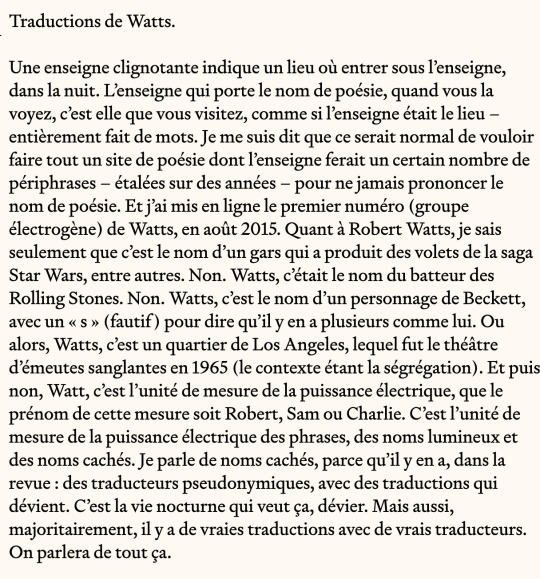
Le 27 avril au CipM, avec Samuel Rochery, Philippe Hauer (des éditions Vanloo), et Simon Brown ! https://cipmarseille.fr/programme/4782
0 notes
Text
Ladyhawke: The Story
When you boil it down, the story of Ladyhawke isn’t quite a tale as old as time, but it’s pretty darn close.
Ladyhawke tells the story of star-crossed lovers, suffering under a curse that stands between them. It is the tale of a couple who struggle to remain hopeful, to find a way to break the curse, to end their suffering. It’s a common theme, used everywhere from Romeo and Juliet to Buffy the Vampire Slayer. Stories of star-crossed lovers are extremely prevalent, which unfortunately means that it’s rather easy to turn their accounts into stale, cliché-filled, predictable stories.
Ladyhawke, on the other hand, managed to avoid this with one, very simple change: They told the story from the outside.
Enter our ‘main’ character, Phillipe Gaston. (Spoilers below!)
The story of Ladyhawke begins with two events going on at the same time, in the same place: A service in the cathedral above, led by the corrupt Bishop of Aquila, (John Wood) and an escape through the drain system below, performed by petty thief Phillipe ‘The Mouse’ Gaston. (Matthew Broderick)
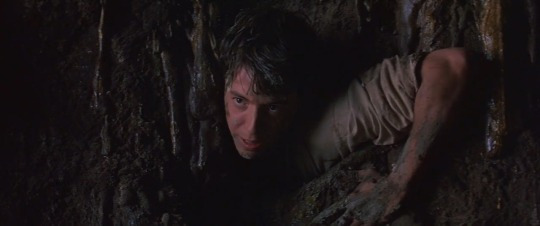
His escape from his impending execution causes quite a stir among the guards of Aquila. As it turns out, the prison of Aquila is impregnable, totally inescapable and thoroughly secure to the point where absolutely nobody, barring Phillipe, has ever escaped before. In order to ensure that this reputation remains untarnished, the Bishop sends the guards, led by Captain Marquet, after him in an attempt to return him for execution.
“Great storms announce themselves with a simple breeze, Captain, and a single rebel spark can ignite the fires of rebellion.”
Phillipe gets away okay at first, traveling outside the city and stealing a change of clothes, a dagger, and some money. His elation and confidence get the better of him however, and he foolishly announces to an entire inn that he is the lone escaped prisoner from Aquila. Unfortunately, among the patrons of the inn are Captain Marquet and his posse.
Philippe, for all of his useful abilities, isn’t quite up to fighting off an entire squad of armed men, and though he does his best to evade them, (even slicing Marquet in the cheek with his newly acquired dagger) it isn’t quite enough to ward them off. The soldiers restrain him, and prepare to kill him. Right before the sword falls, however, who should arrive but a Knight in Shining Armor?

This strange and mysterious newcomer, armed with both sword and crossbow, turns out to be Etienne Navarre (Rutger Hauer), the former captain of the guard of Aquila. He rescues Phillipe, fending off the guard quite handily, and rides off on his black horse, accompanied by a faithful hawk, and a rather unwilling Phillipe.
That evening, Navarre and Phillipe stop off for a rest in a barn owned by a suspicious farming couple. As darkness falls, Phillipe is charged with taking care of Navarre’s massive horse, Goliath, and gathering firewood. Anxious to get further away from Aquila, Phillipe decides to tell Navarre that he is leaving, just before he is attacked again, this time by the aforementioned suspicious farmer. This time, however, his rescuer takes the form not of the great, black knight, but of a great, black wolf.
Terrified out of his mind, Phillipe flees back to the barn to discover that Navarre is nowhere to be found. In desperation, the young thief grabs the former captain’s crossbow, and prepares to try to kill the wolf, but is stopped by a figure even more mysterious than the missing captain.

A strange, beautiful woman in a black cloak (Michelle Pfieffer) prevents him from shooting the ferocious animal, and to Phillipe’s stunned amazement, calmly leaves the safety of the barn, going out to meet the wild creature. The wolf comes to her, quietly and tamely, and the pair walk off into the forest. Phillipe is left in shock, attempting to convince himself that he is dreaming.
Already, we know quite a bit about our main characters. Philippe is totally alone in the world, and is very concerned with the safety of his own skin. He’s not exactly a coward, but he is certainly a sly person, using his wits to get what he needs rather than brute force. He’s an Action Survivor, not a fighter, and he knows he’s not much help in combat. Indeed, he seems to alternate between being terribly proud of his own cleverness, and knowingly humble about his own shortcomings, depending on his familiarity with what’s going on.
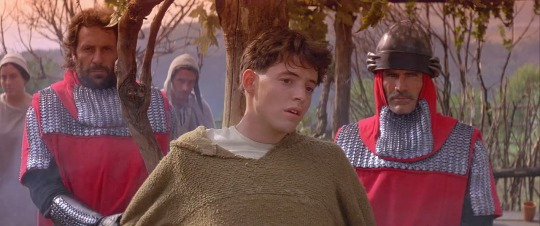
Another interesting quirk of his is that he is almost disconnected with the story, spending a good deal of the narrative talking to God, making plenty of observations about the goings on in the plot. The audience hears his external monologue that comes across as wavering somewhere between flippant and earnest. He’s a shrewd chatterbox, accustomed to his place in his own world, and very uneasy about being drug into a grander tale that he does not belong to. He is very much an outsider, stumbling along with the story in a confused, frantic state, gathering information at the same rate as the audience is, unwillingly pulled into a conflict that, at this time, he wants no part of. It’s almost a direct inversion of the traditional Hero’s Journey. In a way, it seems quite odd that this ‘Mouse’ is our main character, when really, shouldn’t it be the fierce and mysterious Black Knight?
Navarre serves as excellent contrast. He is quiet, reserved, and carries with him a very stern presence, an underlying dangerousness that comes out in battle. He patiently tolerates Phillipe’s behavior for a reason that, as of this point, both Phillipe and the audience aren’t aware of yet. He is gentle with his horse and the equally mysterious hawk, and yet a capable and ferocious warrior in battle. As the ex-captain of the guard of Aquila, he also carries with him an unknown history that connects him with events prior to Phillipe’s escape. In a more traditional fantasy, it would be he that the audience is following. Navarre is the one with an unspoken quest and sense of purpose, and it is Navarre and his actions that drive the story.

And finally, there is the strange woman that has appeared out of nowhere, and disappears into nowhere again in the morning. She has a strange connection to the wolf, and is a lady of few words. At the moment, that is the extent of our knowledge about her, but we are instantly aware that she is vital to this story.
The next morning, Phillipe tells Navarre about the events of last night. Navarre, for his part, takes special interest in Phillipe’s description of the enigmatic woman, asking if she spoke, what she’d said, and her name. The Mouse, with very few answers for Navarre’s questions, is left perhaps more confused than when he’d started.

Meanwhile, Captain Marquet returns to Aquila with bad news: Not only is Philippe still on the loose, but the ex-Captain Navarre has returned. The Bishop reacts rather strangely; he is less interested in their escaped prisoner and the trouble-making warrior than what travels with them: the hawk. He orders Marquet to ensure that the hawk is unharmed, and sends him back out to go search for the two fugitives.
Back in the woods, Navarre finally explains his plans: His quest is to kill the Bishop, and he wants Phillipe, the only escaped prisoner from the medieval version of Alcatraz, to help him. By using him to get in, Navarre will enter the church and strike the Bishop down with the sword of his ancestors, adding his own jewel to the set that adorn the hilt of the weapon.
Phillipe is less than thrilled with this prospect, having just escaped from there, and has this to say:
“There are strange forces at work in your life. Magical ones that surround you. I don’t understand them, but they frighten me. You have given me my life. The truth is I can never repay you. I have no honor, and never will have. I don’t think you would kill me for being what I am, but better that than to return to Aquila.”
However, thanks to some…..convincing by Navarre, he is left with no choice but to stay.

Very subtle.
That night, with Navarre nowhere to be found, the woman appears again, stumbling across Phillipe, who has been tied to a tree to prevent his running off again. Making good use of his silver tongue, he convinces the woman to free him. Once released, the Mouse scurries off into the woods.
Of course, that doesn’t exactly go as planned, either. He is once again apprehended by Marquet and the guards, who attempt to use him to find Navarre. The next morning, Marquet leads an ambush against the knight, and in the scuffle, both Navarre and his beloved hawk are shot with a crossbow. Despite his wound, Navarre defeats the guard and saves Phillipe again, and immediately rushes to the side of his bird.

Navarre gives the hawk to Phillipe, instructing him to ride as fast as he can to the abandoned ruins of a castle, now inhabited by a priest-turned-monk named Imperius (Leo McKern). Phillipe does so, and arrives shortly before sunset. The monk, a disgraced, but sincere man of God, brings them in, and immediately sets to caring for the hawk, locking Phillipe out and speaking soothingly to the animal.
You can all guess what happens when night falls.
Phillipe picks the lock and lets himself in, and realizes what the audience has likely figured out by now: The hawk and the woman are the same person, animal by day, human by night.

After tending to her wound, Imperius explains.
The woman is named Isabeau, and again, as one might have guessed, she and Navarre are deeply in love with each other, and have been for quite some time. Years previously, she was pursued and lusted after by the Bishop, and by rejecting his advances, (and returning Navarre’s) enraged him to the point of bitter insanity. Though the pair tried to keep their love a secret, the Bishop found out, and after consulting with the supernatural, comes up with a demonic curse: as mentioned before, Isabeau is a hawk by day, human by night, and Navarre is human by day, and the great black wolf by night. Forever together, eternally apart.

The monk’s part in all of this? He is the one who mistakenly told the Bishop of their love, indirectly causing the couple these two years of pain. Now, desperate for forgiveness and atoning for his role in the story, he has good news: there is a way to break the curse.
Here lies perhaps the greatest piece of genius in this story. In some contemporary fantasy films of the time, there are neat little devices thrown in to offset the epic-ness, the strangeness, or the fairy-tale-ness of whichever story is being told. In Labyrinth, the items in Sarah’s room follow her into the fantasy world she travels to, grounding it in real-life elements. In The Princess Bride, Fred Savage interrupts Grandpa Peter Falk to insert his own comments about his disgust or outrage with the story going on. In Ladyhawke, however, the addressing of its own ‘fairy-tale’ vibe is done from within the narrative, namely through Phillipe.

Although Phillipe serves as the audience’s window into this world, the fact is, the audience is likely to pick up on things much faster than the Mouse does, very simply because we know we are watching a story play out, and Phillipe doesn’t. As far as he knows, he is just going through life, stumbling upon what he slowly realizes is a story. He is an observer, unconnected to these people, figuring it out as he goes along. As early on as the first encounter with the wolf, he begs God to not involve him in this, recognizing magic and mystery at play. Despite this vague glimmer of genre-savviness, the identities of the animals don’t truly dawn on him until they are staring him in the face. It takes the evidence of the arrow in Isabeau’s shoulder, matching the wound of the hawk, to convince him of the truth: that he has stumbled into a fairytale.
Thus, he needs things explained to him, and he, similarly to Fred Savage, comments aloud (repeatedly) the strangeness of the situation and his place in it. Phillipe serves as the ‘real world’ tie in this fantasy story, albeit a more grounded one than the examples above. He is the exact amount of ‘realism’ necessary for this story, which is frankly, not a lot. He can afford to be both fascinated and skeptical of the story, both moved and objective about Navarre and Isabeau’s plight because the story itself also straddles that line between the utterly fantastic and the grounded, down to earth realism of medieval Europe. It’s a fascinating balance that comes to a head here, halfway through the story, heralded by the first glimmer of hope for the star-crossed lovers.
At dawn, there is another attack by the Bishop’s guards, fended off by the unstable architecture of the crumbling ruins and a well-timed transformation by Isabeau. This scene, while giving us the privilege of ‘seeing’ Isabeau turn into a hawk, also begins to escalate things on the enemy’s side. Defeated once again, the Bishop sends out another force: a hunter with a specialty for wolves.
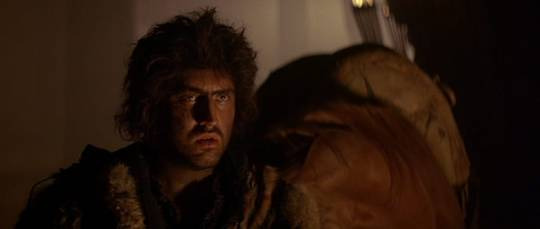
The Bishop’s orders are clear, and give us considerable insight into his motivation:
“A beautiful woman with alabaster skin and the eyes of a dove. She travels by night, only by night. Her sun is the moon. And her name is… Isabeau. Find her and you find the wolf. The wolf I want. The wolf who… loves her.”
What a nice guy, right?
When Navarre arrives in the morning, Imperius and Phillipe go to meet him with their news. The Bishop’s evil curse can be broken if Navarre and Isabeau stand before him, confront him as man and woman, both human, which can only be done on ‘a day without a night, and a night without a day’. Navarre, long hardened and discouraged, dismisses this hope as the ramblings of a drunkard, and takes Phillipe and the hawk to continue his plan of slaying the Bishop.
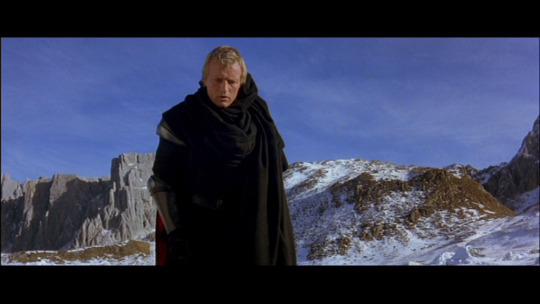
Ironically, with the tables turned, Phillipe finds himself attempting to persuade Navarre of this one chance, secretly telling Imperius to follow them. Navarre, as stubborn as he is heartbroken, refuses to listen, and orders Phillipe not to tell Isabeau of this possibility.
One night, while Isabeau and Phillipe are talking, they meet the wolf-hunter that the Bishop has sent after them, who has ridden in with fresh wolf-pelts. The hunter realizes that this is the woman that the Bishop is after, but before he can do anything, Phillipe has his first moment of real, honest-to-goodness bravery. Drawing Navarre’s sword, he threatens:
“If you lay one hand on her you will find it on the ground next to your head. Now ride on!”
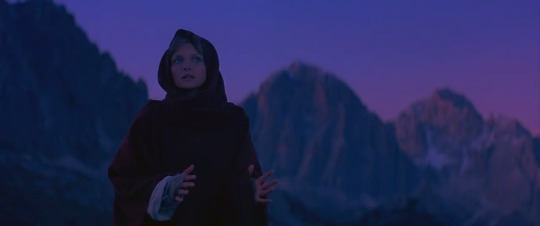
Desperate in an effort to find and save Navarre, Isabeau dashes into the woods, with Phillipe behind her. Isabeau’s connection with Navarre, even in wolf form, allows her to prevent him from stepping into a wolf trap, sending the hunter himself into one instead. The danger is not over, however, and during a further scuffle, Navarre falls through the thin ice over a body of water.
Phillipe, selflessly throwing himself into danger for the first time, goes in after him, acquiring a series of deep scratches on his chest from the wolf in the process. Assisted by Isabeau and Imperius, he deposits the wolf near their campsite, where the ‘Ladyhawke’ waits for him to awaken at dawn.
(This leads to my questions about the pair’s sleep schedules, but I suppose that’s not really important.)

At daybreak, Navarre and Isabeau lay eyes upon each other, and almost touch in their short moment before Isabeau’s transformation. Too soon, the moment is gone, and the Ladyhawke flies off, leaving Navarre crushed.
Navarre, unable to find his family sword, lashes out at Phillipe when the Mouse tells him that he lost it during the night. The knight’s anger quickly dissipates, however, when Phillipe’s shirt falls open and the former captain sees the scars left from his animal form’s panic. Staggered and grateful, Navarre embraces Phillipe, and finally agrees to try to break the curse. That night, Imperius and Isabeau smuggle Wolf!Navarre into the city while Phillipe goes back the way he came: through the sewers.

The next morning, the sun rises as usual, and Navarre, unable to see any sign of this ‘day without a night’ stuff, reverts back to his original plan: when Phillipe opens the cathedral gates, Navarre will ride in and slaughter the Bishop. He orders Imperius to kill Isabeau if he fails, which shall be signified by the cathedral bells chiming as usual.
The plan goes off without a hitch. Phillipe gets the doors open and Navarre rides in, full of righteous fury, now blocked from his revenge only by Captain Marquet. During their brutal duel, Navarre sees something that makes him stop in his tracks: a solar eclipse.
Realizing that the curse can be broken, he attempts to rush back to tell Imperius to spare Isabeau, but it is too late. The bells chime, and Marquet closes in. Despairing and grieving, Navarre fights more brutally than ever, and after being thrown his sword (carried by Phillipe, who, turns out, did not lose it), ends Marquet’s life and turns on the Bishop.
He is halted once again, this time, by something good.

Isabeau enters the cathedral, in full light of day, not a feather to be seen. Together, she and Navarre stand before the Bishop, breaking the curse once and for all. Enraged, the Bishop moves in, intending to stab Isabeau in the back, declaring: “If I can’t have her, no one shall!”
Now it’s his turn to be stopped in his tracks, pretty permanently, by Navarre’s family sword embedded in his torso, thoroughly killing him.

What a shame.
Navarre and Isabeau embrace joyfully, reunited at last. The couple thanks both Imperius and Phillipe, and as the monk and the thief bow out, the happy couple share a kiss, looking forward to a life untarnished by curses.

It’s a satisfying end to a thoroughly satisfying movie. A bit expected, but come on, who doesn’t like a happy ending?
The only thing that could come across as a little odd about this ending is simply who it’s about.
In a way, it makes perfect sense. Of course we want the curse broken, of course we want the couple reunited and for the scummy Bishop to get what’s coming to him. But what we also might want would be some resolution for our supporting protagonist here.
What about Phillipe?
As with The Wizard of Oz, it’s easy to think that maybe our main character hasn’t changed that much from beginning to end. Navarre, on the other hand, has gone from tragic avenger to hopeful hero, together with his love at last. Isabeau is a person grown stronger through adversity, remaining loyal and relieved to be released from the curse. Even Imperius is a new man, redeemed from his accidental betrayal by his assistance.
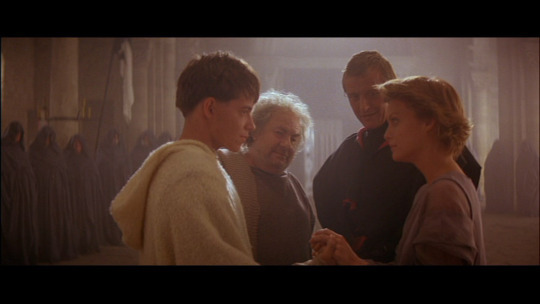
But Phillipe? Where does his end come in?
The answer lies a little before the main climax.
The scene on the ice, where Isabeau tries to slide across to rescue Navarre in wolf form, is, in my opinion, the resolution to the Mouse’s character arc, where he goes from Action Survivor to hero. By diving in after Navarre, putting himself in peril to save his friend, he sheds the remains of his selfish, thieving qualities and gains the honor that, earlier in the film, he said he was without.
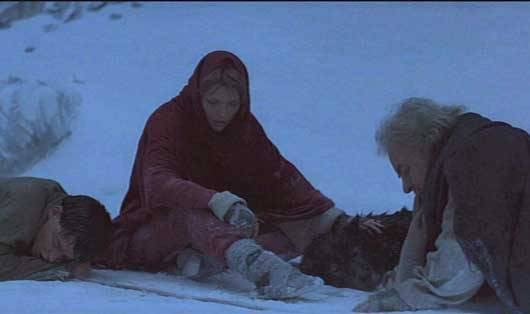
That is where the change is completed. That is where Phillipe becomes a hero. And that is what allows him to put Navarre and Isabeau first. Beginning the story alone in the world, Phillipe gains friendship and respect from notably Navarre, giving the young thief a new place in a larger world.
True, the climax of the film belongs to Navarre and Isabeau, as it should. They are the cursed couple. They are the main focus, even if they aren’t the protagonists. They are the ones who have earned this ending, and deserve it.
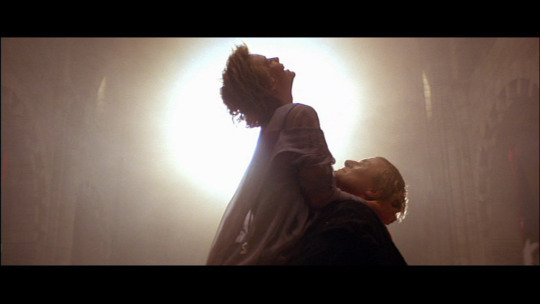
In that sense, the end fits perfectly. Everyone grows, everyone changes, and everyone gets their happy ending. Now that’s what I call a great fairy-tale.
In the articles ahead, we’ll be taking a look at some more of the aspects of Ladyhawke, so please, if you enjoyed this one, stick around for next time! If you’d like, don’t forget that my ask box is always open. Thank you guys so much for reading, and I’ll see you all in the next article.
#Ladyhawke#Ladyhawke 1985#1985#80s#Film#Movies#Fantasy#Adventure#PG-13#Rutger Hauer#Michelle Pfeiffer#Matthew Broderick#John Wood#Leo McKern#Richard Donner
5 notes
·
View notes